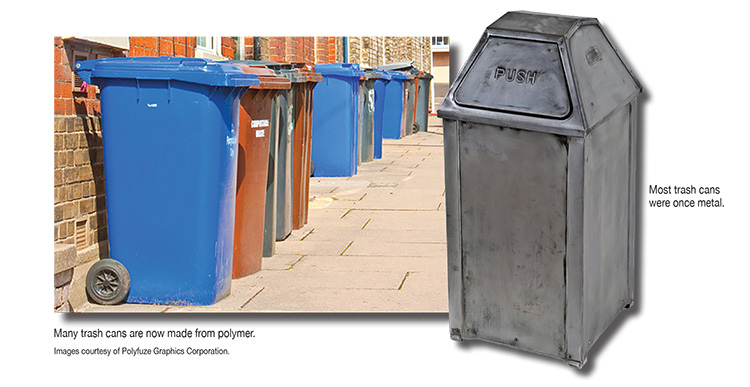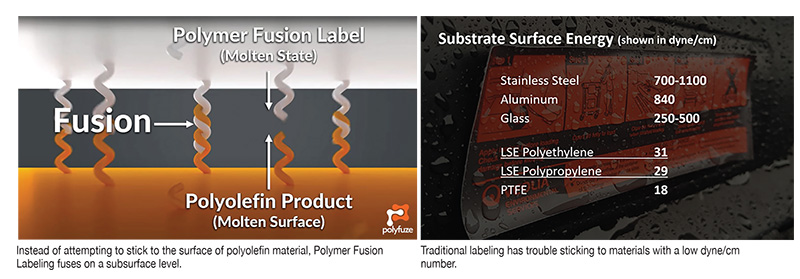What is polymer fusion labeling and why are companies in waste and recycling industry using it?
By Marty Mares and Noel Daigle
Before the modern innovation of plastic roll-out trash bins, carts, and recycling receptacles which are commonly found everywhere today, many of these products were made from metal. However, during the last several decades, polyolefin thermoplastics like polypropylene and polyethylene have become the material of choice for the industry, due to many desirable qualities. Polyolefin products are chemically inert, durable, affordable, impervious to UV, the elements, chemicals, solvents, and the material fluctuates with extreme hot and cold temperatures. Its advent disrupted the waste industry and represented a literal shift from one material, metal, to another, thermoplastic polyolefin.
The properties that make polyolefin thermoplastics so versatile for the waste industry also present a serious challenge for traditional labeling methods like hot stamp foil, heat transfers, and In-Mold Labels (IMLs). As polyolefin polymers have replaced steel and aluminum, waste haulers and municipalities are still turning to traditional labeling methods for their carts, cans, bins, and receptacles, even though they have a really hard time “sticking” to the surface of plastic.

Challenges Associated with Traditional Labeling Methods
One problem comes in the form of incompatibility. Physical properties of traditional labeling methods are inherently resistant to the physical properties of thermoplastic polyolefins like polypropylene and polyethylene, which are used in the manufacturing of waste carts and recycling bins. A second problem comes from the fact that polyolefin plastic has an especially high rate of expansion and contraction, especially for parts used outside.
To break the first problem down in easy-to-understand terms, Polyolefin Thermoplastic has a surface energy level similar to Teflon™. Just like Teflon™, nothing wants to stick to its surface. Think of a bottle of glue, for example. The glue does not stick to the inside of the bottle because the inherent nature of this type of plastic is to repel anything trying to stick to it. This is exactly how Polyolefin Thermoplastics work, too. They “repel” anything trying to stick to their surface, which includes traditional labeling methods like hot stamps, heat foils, in mold labels, and stickers.
In addition to surface energy issues, traditional labeling methods must overcome the challenge of staying on the surface of a part that is continually expanding and contracting. In situations where labeling is required for branding or safety requirements, the labeling method used should be just as durable as the plastic container itself (impervious to the elements, exposure to constant UV or chemicals, etc.)
As with every industry, the results of label incompatibility are evident real-world examples. Label durability is a challenge for the waste and recycling Industry, as you can look in any neighborhood and see that labels are fading, chalking, cracking, and peeling.
Furthermore, traditional labeling methods contain a variety of materials like adhesives, protective coatings, bonding agents, and inks which are incompatible with polyolefin plastic and need to be removed before the part can be recycled.

Recent Innovation for the Waste and Recycling Industry
As Polyolefin Thermoplastic continues to replace steel and aluminum as a material used in the production of products in the waste and recycling industry, new technologies have emerged to support manufacturers. In the area of product labeling, a relatively new technology has emerged. Although it is being used by companies like Otto Environmental, Rehrig, and several municipalities, it is still relatively unknown to the industry.
The technology, known as Polymer Fusion Labeling, has been around for almost 40 years now. It was originally developed specifically for Polyolefin Thermoplastics in the roto molding industry, but several years ago was adapted for the higher-volume, faster-paced injection molding sector.
Polymer Fusion Labeling is engineered to overcome the inherently low surface energy and expansion/contraction of polyolefin material and its superpower is not necessarily derived from what it does have, but rather, what it does not have.
It does not use any incompatible materials that traditional labeling methods rely on to “stick,” or “adhere.” In fact, there are no inks, adhesives, bonding layers, substrates, or protective coatings in Polymer Fusion Labeling whatsoever.

Rather, Polymer Fusion Labels are made 100 percent of compatible polymer material that fuses into the subsurface of the plastic on a molecular level to become a literal part of the product. In fact, the technology is more closely related to plastic welding than it is any traditional labeling method. Because of this, it has been referred to as a “tattoo” for the plastic. Once fused in, Polymer Fusion Labels expand and contract with the part during changes to ambient air temperature and the surface of the part.
Because the labels are made of the same material as the product itself, they also have the same characteristics, such as imperviousness to chemicals, UV exposure or weather, temperature extremes, chemicals, solvents, and repeated pressure washing. This also applies to recycling. Polymer Fusion Labels are also 100 percent sustainable and recyclable, and do not need to be removed from the part before it is recycled, and the resin reused.
Waste haulers and municipalities continue to use hot stamps and heat transfers because many of them do not realize that there is another option. Polymer Fusion Labeling is a relatively new option that is starting to gain traction as an alternative because of its durability, ease of use, and production repeatability. Yet, many waste haulers and municipalities do not understand that Polymer Fusion Labeling is an option available through their manufacturer of choice.
As polymers continue to replace metals in the production of products for the waste and recycling industry, development of new labeling technologies will help manufacturers address the challenges associated with the surface of materials like polyethylene and polypropylene. One such labeling technology is leading the way. | WA
Marty Mares is Vice President of Branding and Commercial Development for Polyfuze Graphics Corporation (Clarkdale, AZ), a leading authority for Polymer Fusion Labeling Technology during the past 38 years. Polyfuze labeling is used by some of the top brands in the world including Rubbermaid, General Motors, and Ford. Prior to joining Polyfuze eight years ago, Marty spent the bulk of his career in the cycling industry.
Noel Daigle is Brand Marketing Specialist for Polyfuze Graphics Corporation. Since joining Polyfuze five years ago, Noel has authored a variety of articles on the topic of Polymer Fusion Labeling.
For more information, call (928) 634-8838, ext. 152, e-mail [email protected] or visit www.polyfuze.com.
